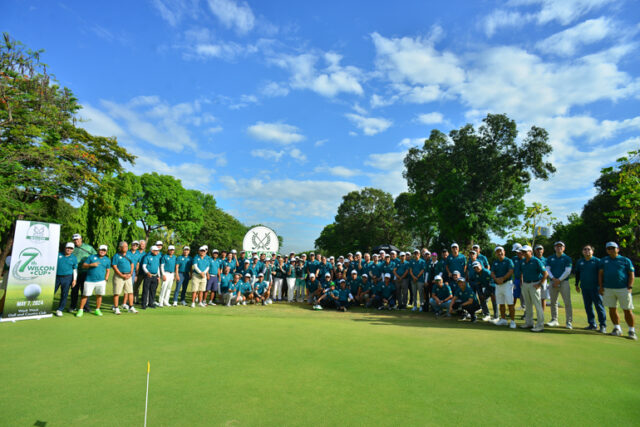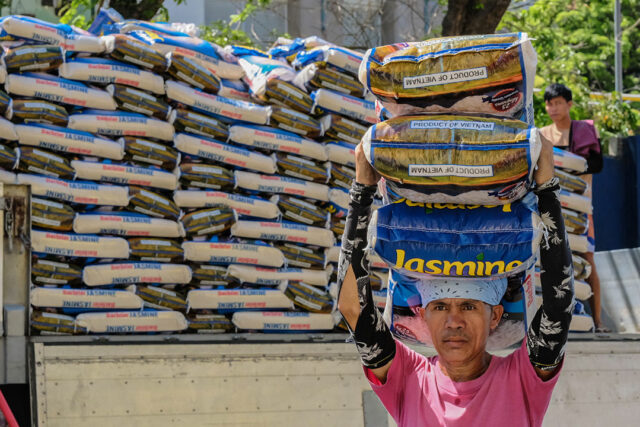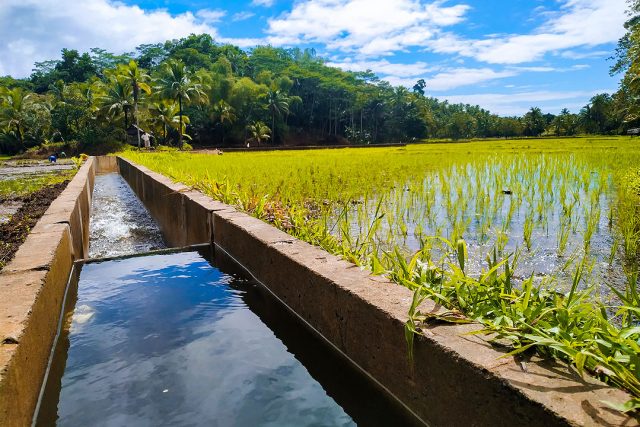By Luisa Maria Jacinta C. Jocson, Reporter
THE BANGKO SENTRAL ng Pilipinas (BSP) is widely expected to extend its policy pause for a fifth straight meeting this week as inflation risks remain.
A BusinessWorld poll of 19 analysts conducted last week showed 17 analysts expect the Monetary Board to maintain its target reverse repurchase rate at a 17-year high of 6.5% at its policy review on Thursday.
On the other hand, one analyst expects the BSP to cut rates by 25 basis points (bps), while another sees the central bank raising rates amid persistent inflation.
 The central bank has raised borrowing costs by a cumulative 450 bps from May 2022 to October 2023 to tame inflation.
The central bank has raised borrowing costs by a cumulative 450 bps from May 2022 to October 2023 to tame inflation.
“The Philippine central bank’s May 16th meeting is likely to see a hold on interest rates. This aligns with their recent cautious approach and the need to balance inflation control with economic growth,” Security Bank Corp. Chief Economist Robert Dan J. Roces said in an e-mail.
Headline inflation quickened for a third straight month to 3.8% in April from 3.7% in March. April marked the fifth straight month that inflation fell within the BSP’s 2-4% target range.
Inflation averaged 3.4% in the first four months, still below the central bank’s 3.8% full-year forecast.
Bank of the Philippine Islands Lead Economist Emilio S. Neri, Jr. said that the central bank will keep its benchmark rate unchanged as “inflation remains uncertain just as growth indicators generally continue to show resilience.”
In a note, Chinabank Research said the BSP would likely maintain its hawkish stance this week, given the risks to inflation and weaker-than-expected gross domestic product (GDP) expansion in the first quarter.
“The country’s GDP growth came in weaker than expected at 5.7% in the first quarter but was still a solid print, outperforming some of our regional peers.
This should provide the BSP room to keep monetary settings unchanged (this) week,” Chinabank Research added.
The Philippine economy grew by 5.7% in the first quarter, faster than 5.5% in the fourth quarter but slower than 6.4% in the year-ago period.
This fell short of the government’s 6-7% full-year target for 2024 and was below the 5.9% median forecast in a BusinessWorld poll of 20 economists.
“The BSP will be careful not to cut rates prematurely as it is anticipating a pickup in forthcoming monthly inflation prints just as risk of inflation reacceleration remains somewhat elevated amid trade, climate and geopolitical uncertainties from August 2024 onwards,” Mr. Neri said.
The BSP has said that inflation could temporarily accelerate to above the 2-4% target range in the next two quarters due to base effects and the impact of weather conditions on agricultural production.
“Our baseline forecasts still point to a breach of the inflation target from May to August due to the continuation of unfavorable base effects amid a challenged supply environment,” Philippine National Bank economist Alvin Joseph A. Arogo said in an e-mail.
Sarah Tan, an economist from Moody’s Analytics, said that inflation may “bump around the upper limit” over the coming months due to the El Niño dry spell.
As of April 30, agricultural damage from El Niño had reached P5.9 billion. Rice was the most affected crop, accounting for 53.21% or P3.14 billion of the total damage.
“We still expect inflation to breach the upper bound of the BSP’s target range in the short term in May, but this should be temporary and we’re hoping that the (Monetary) Board will see past this at next month’s meeting,” Pantheon Chief Emerging Asia Economist Miguel Chanco said.
Union Bank of the Philippines, Inc. Chief Economist Ruben Carlo O. Asuncion also cited other risks to the inflation outlook, such as a potential adjustment to daily minimum wages.
“President Ferdinand R. Marcos, Jr. has ordered a review of the daily wage rates through the regional tripartite wage boards that will be treated as a looming risk to the inflation outlook,” he said.
In June 2023, the wage board in the National Capital Region approved a P40 increase, bringing the minimum wage to P610 from P570 for workers in the non-agricultural sector.
Senators have approved a bill on second reading increasing the daily minimum wage in the private sector by P100.
PESO WEAKNESS
Analysts said that the BSP is likely to keep rates steady amid the recent peso weakness.
“We expect the BSP to remain on hold at the next meeting given the still elevated inflation rate and high pressures on the peso from the stronger US dollar,” Makoto Tsuchiya, an economist from Oxford Economics, said in an e-mail.
The local unit closed at P57.42 against the dollar on Friday, weaker by four centavos from its P57.38 finish on Thursday. The peso returned to the P57-level in April amid the escalating conflict in the Middle East.
“Moreover, the Fed is unlikely to cut rates soon and a reduction in the Philippine-US interest rate differential will put more pressure on the exchange rate to weaken,” Mr. Arogo said.
The central bank is also unlikely to cut rates ahead of the US Federal Reserve, analysts said.
“With the Fed likely cutting rates in September or possibly even later, BSP’s first rate cut will likely follow the Fed action,” ING Bank N.V. Manila Senior Economist Nicholas Antonio T. Mapa said in an e-mail.
Mr. Asuncion said the BSP will likely wait to cut rates “until El Niño effects have receded, local food supply has normalized, and rice inflation has materially narrowed.”
BSP Governor Eli M. Remolona, Jr. has said that while the central bank monitors the Fed, its decisions are independent of the Fed’s own moves.
The US central bank kept its Fed funds rate steady at 5.25-5.5% at its latest meeting.
“The latest inflation data is still within the BSP’s inflation target of 2-4% for the fifth straight month that could still support possible local policy rate cuts later in 2024, especially if the Fed starts cutting rates,” Rizal Commercial Banking Corp. Chief Economist Michael L. Ricafort said.
Capital Economics Senior Asia Economist Gareth Leather sees the BSP cutting rates starting as early as August.
Meanwhile, Moody’s Analytics Ms. Tan said that the odds of a rate hike at Thursday’s meeting are low.
“With inflation surprising to the downside, there is no pressure for the BSP to hike its policy rate further in the Monetary Board meeting (this) week. There is also no need to hike to support the peso and prevent any forex-induced inflation with the peso strengthening against the US dollar after the US jobs data came in weaker than expected,” HSBC economist for ASEAN (Association of Southeast Asian Nations) Aris D. Dacanay said.
On the other hand, De La Salle University School of Economics professor Jesus Felipe said that the BSP may possibly raise rates by 25 bps.
“The situation is complicated. On the one hand, inflation uncertainty remains plus the peso depreciation,” he said in an e-mail.
“Our models indicate that the currency will stay at the current level and that inflation will stay in the upper part of BSP’s target, between 3.5% and 4%. This leads us to think that BSP may increase its policy rate,” he added.
Meanwhile, Ser Percival Peña-Reyes, director of the Ateneo de Manila University Center for Economic Research and Development, said that the central bank may consider easing rates as inflation is still within target.
“The BSP might go for a rate cut this time due to weaker-than-expected economic growth. Its decision to do so might be influenced by the fact that inflation came within its target,” he said.
Mr. Remolona earlier said they may consider cutting rates if inflation can settle firmly at around 3% for consecutive months.



 More than a hundred golf enthusiasts, prominent names in the building and construction industry, including media personalities graced the event. The day began with ceremonial tee shots from Wilcon Depot Founder & Chairman Emeritus Dr. William T. Belo, President and CEO Lorraine Belo-Cincochan, SEVP-COO Rosemarie Bosch-Ong, and Boysen Philippines Ambassador Derek Ramsay.
More than a hundred golf enthusiasts, prominent names in the building and construction industry, including media personalities graced the event. The day began with ceremonial tee shots from Wilcon Depot Founder & Chairman Emeritus Dr. William T. Belo, President and CEO Lorraine Belo-Cincochan, SEVP-COO Rosemarie Bosch-Ong, and Boysen Philippines Ambassador Derek Ramsay. The 7th Wilcon Cup champions (West Course) were Jaime Alberto Melo for Division I and Arturo Alcantara for Division II. The runners-up were Edgar Allan Pasion and Arniel Caeser Idos, respectively. In the ladies’ division, Ashley Llena was hailed as the champion.
The 7th Wilcon Cup champions (West Course) were Jaime Alberto Melo for Division I and Arturo Alcantara for Division II. The runners-up were Edgar Allan Pasion and Arniel Caeser Idos, respectively. In the ladies’ division, Ashley Llena was hailed as the champion.















